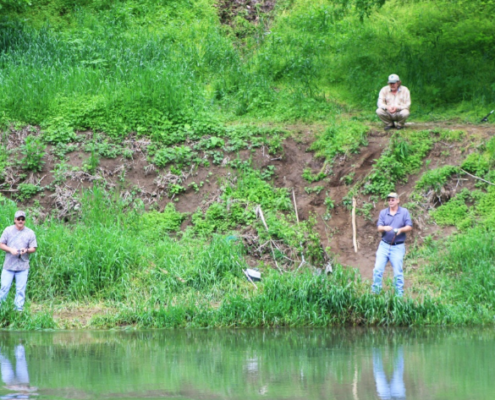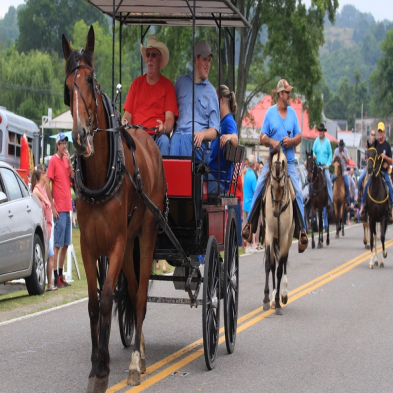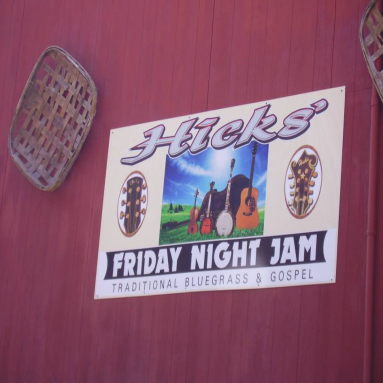Clinch River
The Clinch River is the crown of the mountain empire flowing southwestward from its origin near the town of Tazewell, the Clinch travels some 135 miles, reaching portions of Tazewell, Russell, Wise, and Scott counties on its way to the Tennessee state line. In a cast of Virginia rivers that portray history and natural wealth, the Clinch has a story and a character all its own.
The Clinch River, which was named after on otherwise forgotten explorer, played a major role in the exploration and settlement of Southwest Virginia. Many early settlers made their homes along its eastern shore, while other crossed the formidable flow and explored the wilderness beyond its banks. Probably the most famous explorer to pace the banks of the Clinch and challenge its currents was Daniel Boone. Boone resided for some time near Castlewood, and negotiated the river during his many trips through Southwest Virginia. Today, towns and settlements along its course bear names which are evidence of their historical roles. Places like Blackford, Nash’s Ford, Fort Blackmore, and Speer’s Ferry are a few examples.
The Clinch supports a unique assemblage of aquatic life. The river is home to about 50 species of mussels, which is more than any other river in the world and over 100 species are non-game fish – minnows and darters that sport brilliant colors and play a vital role in the survival of other fish and mussel species. But, the variety of sport fish is what makes the Clinch a great destination for anglers.
The Clinch River has a lot to offer those who want to escape the familiar and explore the life of a river. Whether you come to experience the fishing, or just to view the spectacular scenery, please keep safety in mind. Be sure that you are aware of your boat’s and your own limitations. Before floating an unfamiliar stretch of river, boaters are advised to use a topographic map to look for ledges and falls. Remember, discretion is the better part of valor. Wear your life jacket, and if you think you might have trouble negotiating a piece of water, portage your boat and equipment around the obstruction. Some of the access points noted on the map are informal sites that have traditionally been used by anglers and floaters. To ensure that these sites are available for future use, respect all property. Please refrain from littering, and do not block roads or gates.
Fishing Opportunities
Smallmouth Bass River Fishing Forecast
Many gamefish species that have been stocked into other Virginia rivers are native to the Clinch. Among the native gamefish in the river are the smallmouth bass, spotted bass, walleye, and sauger. In fact, the Clinch and its tributaries are the only Virginia waters where sauger are present. Largemouth bass, rock bass, redbreast sunfish, longear sunfish, and bluegill sunfish are available, as well as musky, black crappie and freshwater drum. Anglers who are looking for catfish will find both channel and flathead catfish in good numbers and sizes.
Observant anglers may also notice longnose gar “sunning” near the river’s surface and occasionally taking a gulp of air. Strong populations of redhorse suckers and carp are available for anglers with the prowess and inclination to pursue them. These bottom-feeding fish can be caught on small pieces of worm fished on small hooks and light line, especially during the spring months. Redhorse suckers are most visible in the shallow water near the tails of pools. In Scott County, these shoals are the focal points of a unique spring tradition – the sucker shooting season. From April 15 to May 31 enthusiasts climb to platforms built in trees along the river to gain a better view of the river. These shooting platforms are often located at perilous heights, and are easy to spot when floating the river.
Miller’s Yard to Dungannon
Map
Distance: 3.7 miles
Gradient: 10 ft/mile
This is a good float when you do not have a lot of time. Put in at the informal access at Miller’s Yard. Several good pools and lots of runs and riffles await you downstream. This float has excellent potential for bass and sunfish, and also produces walleye and sauger. Takeout is on the right, just downstream of the Route 65 bridge at Dungannon. If you have all day to float you can extend your float to Route 659 described below.
Dungannon to Route 659
Map
Distance: Variable
Gradient: 10 ft/mile
The Dungannon access is one of only two concrete boat ramps on the Clinch River. This is a productive float for smallmouth, walleye, sauger, sunfish and catfish. A variety of takeout possibilities exist along route 659, which parallels the river for several miles. Select a sire based on the distance you wish to float and available access to the river. It is best to secure permission from the property owner when selecting a take out location.
Route 659 to Fort Blackmore
Map
Distance: 8 miles*
Gradient: 3.1 ft/mile
*The distance of this float depends on where you launch from route 659, but will be at least 8 miles. This float includes a lot of flat water. The slow and deep pools are good habitat for sunfish, catfish, walleye, and musky. Bring an electric trolling motor for this float, or be prepared to spend some time paddling. This float includes the pool know locally as “the retch” – a pool that stretches almost five miles with an average depth of about 14 feet. Some of the best musky fishing on the Clinch River is found in this float. Striped bass and white bass, migrants from Norris Reservoir in Tennessee, are sometimes caught on this float. Takeout is on the left, at an informal access just downstream of the Route 72 bridge in Fort Blackmore.
Fort Blackmore to Hill Station
Map
Distance: 7.9 miles
Gradient: 1.9 ft/mile
This is one of the most scenic floats on the river. Just downstream of Fort Blackmore lies Pendelton Island. Fishing is this section is good for bass and sunfish, and walleye and sauger are also available. The gradient is low in this section, so floaters should allow plenty of daylight time to reach Hill Station. Takeout is on the left side of the river, just upstream of the route 645 bridge. The Hill Station access can be found off of route 645 on the southeast side of the river.
Hill Station to Clinchport
Map
Distance: 5.2 miles
Gradient: 2.0 ft/mile
Put in at the Hill Station access described above. This section is typical of the lower river. Lazy pools provide good fishing for sunfish and catfish, while faster water at the scattered riffles offers smallmouth bass fishing. Take out on the right side of the river at the Clinchport access.
Clinchport to Speer’s Ferry
Map
Distance: 2 miles
Gradient: 3.2 ft/mile
A good variety of habitats are encountered on this short float, and many species can be caught. Launch at the Clinchport ramp and tie on a small, deep-diving crankbait. The first section of this float will offer some good bass and sunfish water, while ledges in the last stretch will harbor walleye and sauger. Take out on the left side of the river at Speer’s Ferry. An informal access is located near the railroad bridge off of route 627.
Speer’s Ferry to State Line
Map
Distance: 9 miles
Gradient: 2.5 ft/mile
This float will take anglers through some beautiful scenery on the way to the Virginia-Tennessee border. Most of this float is through slow moving water, so allow ample time to cover the distance between access points. The scattered shoals in this section are popular during the spring sucker shooting season. Be sure to notice the platforms placed high among the sycamores. Take out is on the left side of the river at the State Line access, off of route 627.







